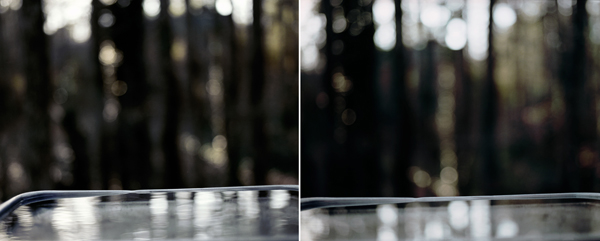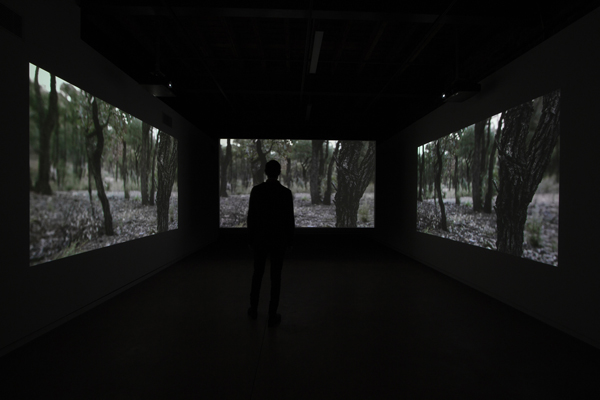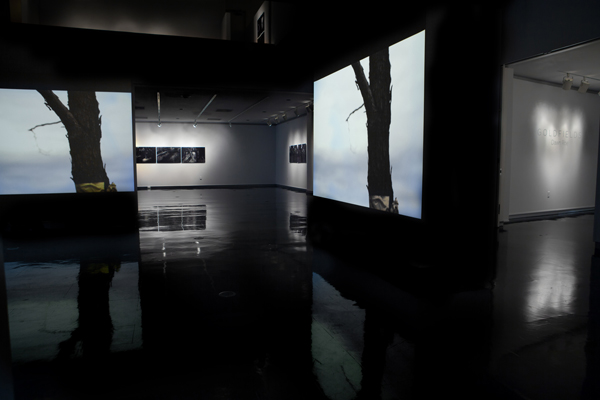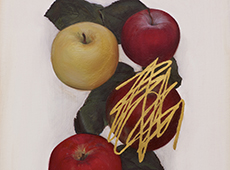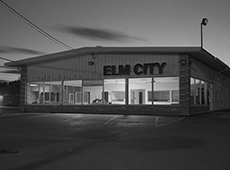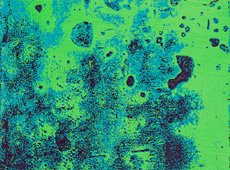I’m definitely conscious of this kind of rhythm, and am always preoccupied with ensuring that a sort of lyrical quality permeates both my imagery and its eventual arrangement. When I’m making photographs or capturing video, I’m certainly aware of the general aesthetic sensibility that tends to drive my response, but I guess my process at this stage is more about sort of gathering material, collecting.
This is the third installment in a Tilted Arc ongoing feature, Women in the Landscape—conversations between women photographers whose work focuses on the land.
This conversation is with Dawn Roe, an artist and educator working in still and moving images. Her work focuses on the perception of space, memory and the ambiguous landscape.
Dawn Roe, “From Time to Time (Red Curtain),” from the series,
“I’m interested in the associations that arise from this kind of recognition (of a place or a detail) – but it’s not important to me whether I am describing these spaces in a manner that offers any particularly useful information.”
So in this way the photograph does seem to create a record of sorts, one that allows something that has been, but no longer occupies the same slice of space and/or time, to emerge again, visually. But, of course, in a two-dimensional form – distinct from experience. And this kind of thinking leads me to all sorts of different problems that are attached to the expectations that accompany our experience of/with photographs, which is distinct from our experience of making photographs, or of just being in the world in general. So, I guess I’m just not sure that the medium really allows for the communication of passing moments. I think a semblance is offered in the form of a representation, but the very nature of the process of photography – generally constrained to exposures encompassing mere fractions of a second – produce documents of instants, rather than moments. And to me there is a difference, admittedly sometimes slight. That’s the space I’m interested in though, and that is why this time-based medium is so important to me. I should say, this also has a lot to do with why I choose to work with both photographs and video footage, side-by-side whenever possible—to draw attention to all of this trouble. Good trouble, though.
…the photograph does seem to create a record of sorts, one that allows something that has been, but no longer occupies the same slice of space and/or time, to emerge again, visually.”
And this relates to my subject matter as well, and the manner with which I reveal or conceal the larger context as you ask above. Years ago, I spent a lot of time making portraits of people in their homes and then photographing myself in my own home – so domestic interiors were repeatedly featured, and the context informed those images a bit as there were details available that offered some indication of how the subjects depicted were living. When the figure disappeared from my work, I became much more interested in smaller, slighter aspects of spaces – both interior and exterior. And this is when perceptual considerations began to dominate. But, I think it’s important to acknowledge that I am still choosing to use recognizable spaces (home, studio, landscape) and am not working in pure abstraction. I’m interested in the associations that arise from this kind of recognition (of a place or a detail) – but it’s not important to me whether I am describing these spaces in a manner that offers any particularly useful information. I hope I’m making sense – a lot of this is coming from the current project I’m working on at an airport where I am an artist-in-residence for the duration of a major construction project. There are so many discrepancies between what I’m doing and what the public expects an artist (working with a camera) to be doing!
Dawn Roe, “From Time to Time (Water),” from the series,
But perhaps I’m wrong to think that the medium doesn’t allow for the communication of passing moments, as it’s really the singular image that I’m pushing against. Whereas, multiple frames exposed in close proximity (spatially and temporally) and presented in a sequential manner (either in the form of a photograph, film or video) certainly do seem more apt and able to draw upon and/or activate a more temporal interpretive framework and, which is perhaps, less reliant upon the specificity of narrative. Certainly the Dibbets work you reference above achieves this, but I’m thinking here also of structural filmmakers like Michael Snow who push these ideas to the extreme in films like Wavelength, which interestingly purports to contain a semblance of narrative in its opening segments that include figures/actors and a plot of sorts, but it quickly (or rather, slowly I suppose) leaves that behind for the prolonged continual zoom through the space for which the film is known. So, I’m wandering a bit, but I enjoy the way many artists that share these concerns (of time/space/memory) work along the edge of narrative and abstraction, I suppose.
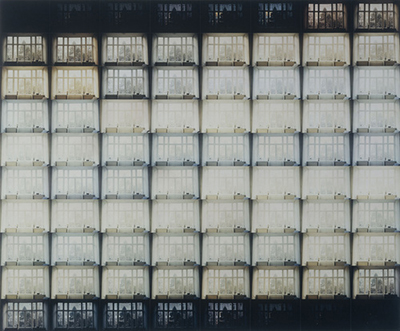
Jan Dibbets. The Shortest Day At My House in Amsterdam. 1970. 69 3/8 x 84 1/4″ (176.2 x 214 cm). © 2009 Jan Dibbets/Artists Rights Society (ARS), New York (Used here under Fair Use guidelines.)
In the midst of thinking about all of this, I came across the work of Karin Apollonia Mueller the other day and was really captivated with two of her series, Timbercove and Gate. She’s doing something similar to both Dibbets and Barth but perhaps more akin to someone like Paul Graham, allowing multiple segments to be seen alongside one another, but very carefully orchestrating how (and to a certain extent, when) each image (or portion or extension of a scene) is encountered (at least on the website, but I presume this method would be used for exhibitions as well as in book form).
But at any rate, I appreciate the sort of flow that comes from this kind of sequencing, almost mimicking a cinematic experience. And you might say then, well, why not just make a film or a video. Sometimes I do, but, I’ve always maintained that the differences between the still and moving image are fundamental to how we read them – as perpetually frozen or endlessly repeating. And playing with presentation strategies to activate different perceptual experiences can be really satisfying. So, I’m most interested in forcing the two to coexist together, in the same space whenever possible.
Dawn Roe, “No One Was With Her When She Died (Wall, Tree, Window)” from the series,
But you’re so right to pick apart the term sequence (of course the term is used differently when speaking of the moving image as I’ve just done above, versus a series of still photographs). In my photo classes specifically, I approach this term somewhat differently with my introductory students than advanced students who are working through ideas and content in a more complex manner. I think learning to build an edit to form a coherent portfolio of work is one thing (and the arrangement of images within that portfolio can be critical to how its read for sure) but to really think about sequencing in terms of an installation practice is a bit distinct from that definition. Which also makes me think about this strategy in relation to book layout and design. I know that your practice includes handmade books, and it’s really nice to hear how you discuss the rhythm and pace determined by the arrangement of images – I can see how this somewhat filmic approach to editing (montage) might be important in your method of bookmaking (which I really admire). It seems the artist’s book is a really fantastic place/form to mess around very deliberately with time and perception – the inherent back and forth of page turning, the pause of the blank page, the (possible) extension of duration.
When I’m going through images and footage at home in the studio, it’s then that I start to think more deliberately about how particular instances flow together with one another, as I begin to juxtapose particular frames next to one another, creating “sets” of still photographs…
And some of this goes back to thinking around issues of the single image as well. Especially in terms of how we are most likely to encounter photographs in general – isolated not only from a possible sequential context but also from their larger, more purposeful context as selections from a personal or public archive, or one of many from a group of carefully selected and arranged exhibition prints or pages from an artist’s book, etc. And, of course, questions of scale come into this predicament as well. Engaging with an image on an iPhone screen is a fundamentally different experience than encountering variously scaled prints on a wall, or again, in the pages of a book. And, of course, this aspect speaks directly to your suggestion of developing a flow or rhythm – something that is very much at the forefront of my own consideration. And I guess I’m conscious or hyper-aware of the quick view perpetuated by online or mainstream press viewing experiences that often spills over into actual art viewing experiences, causing viewers to breeze by works with little time for contemplation.
Dawn Roe, Goldfields, Installation View, Screen Space, Melbourne, VIC, Australia (June, 2012).
© Dawn Roe. Courtesy of Screen Space.
Dawn Roe, Goldfields, Installation View, Clara M. Eagle Gallery, Murray State University, Murray, KY (September, 2013). © Dawn Roe. Courtesy of the artist.
I should also say though, there are many instances where a really good edit/sequence of images can work quite well in a more traditional layout – I’m not fundamentally opposed to this, and have shown my work this way quite a bit – I’m just really interested in thinking about breaking open the space a bit and allowing for a viewing experience that includes a lot of big spaces for pause, as well as one that encourages or relies upon the peripheral glance, both forward and back.
But, to answer your question about my own work – yes, I’m absolutely thinking about creating a dialogue between the still and moving image that allows the viewer to really think about the relationship between the two – and the necessity of viewing one in relation to the other. Especially because my photographs and video works include the exact same imagery – spaces depicted in slight variation in the form of individual photographs presented as diptychs or triptychs and then re-presented in the same compositional form, activated through movement or paused as stilled frames in the form of video – it seems especially important to be really careful about this kind of sameness, and to establish a certain pace or rhythm to the repetition.
And this goes back to my comments above in relation to the notion of patience and the promotion of a thoughtful engagement with the image. I recognize (and enjoy) the fact that there is a certain level of monotony to my work, and that the slowness and seeming banality of the imagery does not necessarily offer up all it has to give with any sort of immediacy. I think the most recent installation of my Goldfields project was somewhat successful in negotiating this territory – cueing viewers into the kind of slow experience the work is asking for immediately upon entering the space, which was sparsely populated with moderately sized photographs hung with ample space between each set, and three freestanding walls serving as the projection surface for a single-channel video presented in triple-projection. Though the walls form a sort of “room” that you can be present in, it is not a space isolated from the gallery itself. And, like the sets of photographs, the walls are situated to have space between them, which allows the still photographs to be seen peripherally and/or through projection spaces. This particular work had been shown previously in different forms, and each iteration has led me to think further about various installation possibilities and its impact on the work.
Dawn Roe, “The Tree Alone (Black Ivy),” from the series,
And, certainly the screen dominated experience you speak of above has perpetuated this type of quick look, and I’m guilty of it myself – which is why I have to force myself to slow down, or return to things. It’s important to distinguish between a cursory glance or skim of the page and more thorough research. This holds just as true for the image as for the written word. As well, it seem all of this photo of the year stuff encourages a less prolonged engagement with the image, promoting the notion that the “best” photographs are stunning, brilliant, grandiose, etc. Evaluating images in this manner often positions the purely decorative image over those that are quieter and more thoughtful. (I think it’s particularly telling that the National Geographic Best Photos of 2013 web pages include links to make the winning images into wallpaper for your desktop or mobile phone).
It takes time to first look, and then (perhaps) to see, and then to begin a process of questioning about why something appears the way it does, why it takes the form that it takes, why whomever created the image (and for what purpose) made certain decisions that resulted in the object of consideration.
But, I’m not suggesting there is anything inherently wrong with beautiful and captivating images. I should emphasize, there are plenty of photographs (or images in general) that I find visually enjoyable, or as Barthes would say, I have a “general, enthusiastic commitment” to – his way of describing what he termed the studium. And, he related relatively banal (in terms of interpretation) unary photographs to this type of reading as well – those that “transform ‘reality’ without doubling it…disturbing it.” We’ve been conditioned to be wowed by these kinds of images, and it’s a real problem in teaching, which relates directly back to patience as well. Often more complex or less immediately accessible images are overlooked or paid less attention to in favor of those that are “cool” or “amazing” or provoke an awed response that leads to questions of “how’d you DO that?!” Certainly not in all cases, but in many, these kinds of photographs contain little beyond the surface. Once we digest its exterior (often with a quick glimpse), there is no need (or desire) to delve further, to think about the relationship between this two-dimensional image and the world it was derived from.
Even though this may seem to have more to do with my mindset as I’m gathering material in the field, this thinking relates to the work’s eventual (or at least its ideal) installation as well. Ultimately, I’m most interested in a kind of photographic representation that aligns itself with philosophical queries of Being. Granted, on the surface, this may sound a bit grandiose, but when looked at closely and even somewhat simply, it makes perfect sense to equate the camera – what it is, what it does and what we do with it – to such fundamental concerns. There is a fantastic quote (that I reference often) in photographer/filmmaker and theorist Hollis Frampton’s essay, For a Metahistory of Film: Commonplace Notes and Hypotheses, that promotes a rather utopic consideration of the very nature of lens-based images, and nicely sums up the way I approach the world when working with the camera.
“A polymorphous camera has always turned, and will turn forever, its lens focused upon all the appearances of the world. Before the invention of still photography, the frames of the infinite cinema were blank, black leader; then a few images began to appear upon the endless ribbon of the film.
A still photograph is simply an isolated frame taken out of the infinite cinema.”
Dawn Roe, “This is Nowhere.” © Dawn Roe. Courtesy of the artist.
I just really love this suggestion of aligning ourselves with the idea of a camera as a very peculiar type of entity – and that this idea in relation to a certain kind of photographic seeing has been ever-present in the world. So, again, for myself it’s very simple to equate the sensibility present in this poetically suggestive passage to my own methods of responding and recording, and it carries further to presentation strategies as well. When I purposefully juxtapose the same or similar imagery in both still and moving forms, I’m hoping to conjure a perceptual response that is similar to being in the world –glancing from side-to-side, up/down/back/forth, looking and seeing, listening and hearing – but does not attempt to simulate any sort of particularly immersive experience. In other words, I’m not interested in creating a meditative space for contemplation or one that is meant to be revered or idealized. Instead, I choose to re-order recognizable fragments into an ambiguous and divided re-presentation. The disruptions between individual, still frames (as presented as diptychs or triptychs) and the repetitious, stuttering of those same images perceived in a slowly moving or sometimes stilled/frozen form (as multi-surface projections) tends to disallow any one image/view/perception to obtain precedence over another – approximating the qualities of perceptual experience, while simultaneously reinforcing the distinction between live, present time and the reactivation of a string of past events.
Now, I had no particular interest in major construction sites until I received the airport commission, but of course now that I’ve been repeatedly visiting and photographing the space for almost a year, I’ve become strangely enthralled with so many of the materials at play in shaping this massive space – thick tracks from machinery imprinted in the earth, mound upon mound of dirt and debris, twisted metal and steel scattered about – all of this amidst the palm tree and mangrove lined wetlands that form the periphery of the airport. I simply hadn’t paid these things much attention before, until I was asked to. So, in this way, being presented with a space was advantageous, but it was also happenstance. In general, it seems I am an observer and a responder, which leads me to pay a lot of attention to the subtle changes that occur over time within particular or similar locales. But in all honesty I’m probably more interested in the general sense of sameness from one landscape to the next, providing the overarching structure that prompts our confounding yet familiar perceptual response.
Dawn Roe, “Airfield Studies (Rebar),” from the series,
There is not much difference for me in terms of my working methods between my backyard or the neighboring woods in North Carolina, a noted historic region in the bushlands of Australia, and a construction site in Florida. I don’t approach the sites any differently – I don’t feel any particular obligation to one space over another (although I do acknowledge that certain locations should be approached more respectfully than others – such as the aboriginal lands in Australia). But, this goes back to my earlier comment that suggested the images I produce might not be terribly useful as information. And actually, I often think about the fact that a pile of rocks is a pile of rocks, a stand of trees is a stand of trees, etc. Sure, they are specific to their locations, but once transformed into a representation – either as a memory image or photograph – this reference is removed. So then, what does it matter whether I was actually in the Australian Goldfields or on a specific construction site? Surely I could make work that had to do with both of those spaces without actually setting foot on or near them, by relying on materials that were closer at hand. And, in fact, some of my projects do involve fabricating crude set-ups in the studio. But, in terms of my process and how I situate my thinking around space and place in general, what matters to me is the initial set of circumstances that led to the response. This usually means physically situating myself within and among a particular pile of rocks, turning around and seeing a very specific stand of trees, looking up and noting the sky, gazing down toward the ground and forward and back again and again. In the end, I’m still not sure why this kind of differentiation within an admitted sameness is important – so I’m kind of stuck in this conceptual and metaphoric space for now. Luckily, I’m okay with that.
Dawn Roe lives, works and teaches in North Carolina and Florida. She is an Assistant Professor of Art at Rollins College and graduated from Illinois State University with a Masters of Fine Arts.
Editor’s Notes:
To download a PDF of this interview, please click here.
To follow the Women in the Landscape series in its entirety, click here.
Subscribe to Tilted Arc
If you like this story, please consider subscribing. We are sticklers for privacy.
We will never sell or share your e-mail address.


